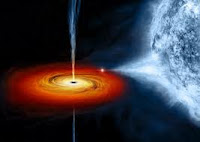That's the allegation
of a paper in this week's Nature by Researchers from the University of Notre
Dame and the University of Illinois at Urbana-Champaign. Processes just after
the Big Bang created ought To Have Certain Amounts of elements Such as hydrogen,
helium, and lithium. Astronomers already knew the universe has far less of the
isotope lithium-7 than it Should - studies of the old stars that surround the
Milky Way
halo in a show that they have at most one-third the amount of lithium-7 Predicted by careful models of what happened in the newborn universe. Some stars in the Milky Way's disk do have more lithium-7, but Generally Such stars are thought to be younger than the halo stars and are polluted by heavy elements THEREFORE made later in the universe's history.
The lithium is a major
thorn in astronomers' sides, because other elements seem to match predictions
just fine. Any Process That Could Destroy The lithium would need to leave
unscathed these other elements, and that's a tricky proposition.
To Dig into This
problem, J. Christopher Howk (University of Notre Dame) and his colleagues
measured the lithium outside the Milky Way. They pointed the high-resolution
UVES spectrograph on the 8.2-meter Very Large Telescope at a massive, young
star in the Small Magellanic Cloud, a dwarf galaxy orbiting the Milky Way.
Light from the star passes through the gas and dust lying between the star and
us and picks up the spectral fingerprints of the elements it encounters.
That item has
interstellar about one-fourth the amount of heavy elements as the Sun. The
value is at least 10 times higher than the heavy-element Levels in many halo
stars, but it's a step in the right direction to studying primordial
abundances, Howk says. The team detected an amount of lithium-7 that's a bit
lower than Predicted That Could but is consistent with the theory of big bang
nucleosynthesis.
This might sound like a
solution to the lithium problem, but it's not. The amount of lithium should
only go up with time as more stars create heavy elements those elements and
then spew into space as the stars age and die. If the Small Magellanic Cloud
now has about the same amount of lithium as big bang nucleosynthesis Predicts,
it had to begin with Less.
"That worries us a
bit," Howk says. "There are a few ways to tune things to get out of
having big bang nucleosynthesis be wrong, but they start to become a bit
uncomfortable."
Miguel Pato (Technical
University of Munich, Germany) and Fabio Iocco (Oskar Klein Center for
Cosmoparticle Physics, Sweden), Who Have worked on the lithium problem , an
interesting point That note in the new paper is the hint Howk and his
colleagues detected of another isotope of lithium, lithium-6. If that hint is
the current level of lithium-6 in the interstellar cloud the team Studied (and
Howk stresses that the data are not strong enough to make that claim), it would
suggest That There's about a thousand times more lithium-6 present than is predicted
by big bang nucleosynthesis. Because the theory predicts how much lithium-6
There Will Be Compared to lithium-7, the amount of lithium-6 could reveal the
mechanism That Made the lithium-7 and determine just how much of it originated
in the universe's first few hours. Howk says his team has more observations
planned for this November to help pin down the amount of lithium-6 present.





No comments:
Post a Comment